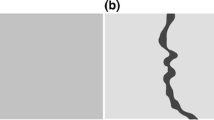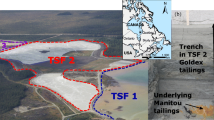Abstract
Integrated surface water and groundwater models are well suited for evaluating the long-term performance of oil sands mine closure landscapes to optimize reclamation designs that satisfy performance criteria. However, the scale of the problem makes it difficult to evaluate a large number of design alternatives using numerical models, while at the same time satisfying numerical criteria, such as the courant and peclet numbers. The problem becomes particularly challenging in the design of permeable sand tailings hummocks overlying relatively impermeable composite tailings, where vertical advective flushing of process-affected water through the tailings hummocks is coupled to lateral transport of diffusive release from the underlying composite tailings. We developed an analytical solution that rapidly estimates long-term mass loadings from the sand tailings without the challenges typically associated with numerical modelling. Advection and dispersion in the flushing zones, progressive diffusion into underlying low permeability layers, and purely diffusive release are all considered. A comparison of the analytical solutions to numerical simulations for a series of simple hypothetical cases demonstrated that the analytical solutions provide a reasonable simulation of the mass loadings from the reclaimed landscapes over the design life. Although the approach needs to be further verified and validated for more realistic complex mine reclamation conditions, the analytical framework provides a foundation for hydrologic analysis in mine reclamation and closure in the northern boreal environment.
抽象
地表水与地下水联合模型适于油砂矿闭坑复垦景观方案的长期运行效果评价,以优化复垦方案,达到闭坑复垦景观运行规范的要求。然而,尺度比例问题使数值模型难以评价更多设计方案,例如库朗数和佩克莱特数。在相对不透水复合尾矿底层上设计渗透性砂质尾矿堆层时,垂向穿过尾矿堆的冲刷水流将耦合下伏复合尾矿底层的侧向弥散释放过程,数值模拟方法遇更大挑战。我们建立一种快速估算砂质尾矿长期物质荷载的解析方法,避开了数值模型困难。该方法综合考虑了冲刷区对流和弥散作用、进入下伏低渗透层的渐进弥散过程和纯弥散释放现象。利用系列简单假设案例进行了数值法和解析法对比,结果表明:解析法能够合理计算复垦景观运行期质量荷载。虽然解析方法仍需要更多实际复杂复垦条件进一步检验和验证,但该方法已经为北方矿山闭坑和复垦工程的水文计算提供分析依据。
Zusammenfassung
Integrierte Grund- und Oberflächenwassermodellierungen sind für die Evaluierung des Langzeitverhaltens von Nachfolgelandschaften des Ölsandbergbaus und zur Optimierung der Rekultivierung entsprechend den Anforderungskriterien geeignet. Das Ausmaß der Fragestellung macht es jedoch schwierig eine große Zahl von Gestaltungsalternativen bei gleichzeitiger Erfüllung numerischer Kriterien wie der Courant- oder der Pecletzahl mit numerischen Modellen zu bewerten. Das Rekultivierungsdesign wird insbesondere dann zur Herausforderung wenn wasserdurchlässige Bergehalden relativ undurchlässige Mischberge überlagern. Die vertikale advektive Durchsickerung des prozessbeeinflussten Wassers durch die Bergehalden ist hierbei kombiniert mit schichtgebundenem (oder seitlichem, flächigem) Transport von diffusiv freigesetztem Wasser aus den darunterliegenden Mischbergen. Es wurde ein analytisches Lösungskonzept zur raschen Abschätzung der Langzeitmassenfrachten aus den sandigen Bergen entwickelt - ohne die bei der numerischen Modellierung üblicherweise auftretenden Herausforderungen. Advektion und Diffusion in den durchströmten Zonen, progressive Diffusion in darunterliegende Schichten mit geringer Durchlässigkeit und rein diffusive Freisetzungen werden zusammengefasst berücksichtigt. Ein Vergleich des analytischen Lösungskonzepts mit der numerischen Simulation für eine Reihe von einfachen hypothetischen Fällen belegt, dass die analytischen Lösungen eine brauchbare Simulation der Massenfrachten aus der Nachfolgelandschaft über den Betrachtungszeitraum ergeben. Obwohl der Lösungsansatz künftig noch für realistischere komplexe Rekultivierungsbedingungen zu verifizieren und zu bewerten ist, ergibt der analytische Ansatz eine Grundlage für die hydrogeologische Analyse bei der Schließung und Rekultivierung von Bergbauen unter borealen Klimabedingungen.
Resumen
Los modelos que integran agua superficial y subterránea son adecuadas para evaluar el comportamiento a largo plazo de los ambientes de cierre de minas de arenas empetroladas para optimizar el diseño de la recuperación que satisfaga los criterios de comportamiento. No obstante, la escala del problema hace difícil la evaluación de un gran número de alternativas de diseño usando modelos numéricos que satisfagan al mismo tiempo criterios numéricos como los números de Courant y Peclet. El problema es particularmente complejo en el diseño de grumos de relaves de arena permeables que están sobre relaves relativamente impermeables, donde el flujo vertical del agua afectada por el proceso a través de los relaves, se acopla al transporte lateral de la liberación difusiva de los relaves compuestos subyacentes. Desarrollamos una solución analítica que estima rápidamente las cargas masivas a largo plazo de los relaves de arena sin los desafíos típicamente asociados con el modelado numérico. Se consideraron la advección y la dispersión en las zonas de descarga, la difusión progresiva en las capas subyacentes de baja permeabilidad y la liberación puramente difusiva. Una comparación de las soluciones analíticas con las simulaciones numéricas para una serie de casos hipotéticos simples demostró que las soluciones analíticas proporcionan una simulación razonable de las cargas masivas de los ambientes recuperados a lo largo de la vida útil del diseño. Aunque la aproximación necesita ser posteriormente verificada y validada para condiciones más realistas, el marco analítico proporciona una base para el análisis hidrológico en la recuperación y el cierre de minas en el ambiente boreal del norte.











Similar content being viewed by others
References
Adams R, Younger PL (2001) A strategy for modeling ground water rebound in abandoned deep mine systems. Groundwater 39(2):249–261
AER (Alberta Energy Regulator) (2015) Oil sands. Retrieved from Feb 25, 2015. http://www.energy.alberta.ca/OilSands/791.asp
Allen EW (2008) Process water treatment in Canada’s oil sands industry: I. Target pollutants and treatment objectives. J Environ Eng Sci 7(2):123–138
Anderson MP, Woessner WW (1992) Applied groundwater modelling. Academic Press, San Diego
Aquanty (Aquanty Inc.) (2017). HydroGeoSphere user manual. Waterloo
Bain JG, Mayer KU, Blowes DW, Frind EO, Molson JWH, Kahnt R, Jenk U (2001) Modelling the closure-related geochemical evolution of groundwater at a former uranium mine. J Contam Hydrol 52(1):109–135
Barbour SL, Chapman D, Qualizza CV, Kessler S, Boese C, Shurniak R, Meiers G, O’Kane M, Hendry J, Wall S (2004) Tracking the evolution of reclaimed landscapes through the use of instrumental watersheds—a brief history of the Syncrude Southwest 30 overburden reclamation research program. Proc, International Instrumented Watershed Symp, Edmonton
Burgers TD (2005) Reclamation of an oil sands tailings storage facility: vegetation and soil interactions, MSc Thesis, Univ of Alberta
Buttle JM, Creed IF, Pomeroy JW (2000) Advances in Canadian forest hydrology, 1995–1998. Hydrol Process 14(9):1551–1578
CEMA (Cumulative Environmental Management Association) (2014) Guideline for wetland establishment on reclaimed oil sands leases. 3rd Edn, Fort McMurray
Cravotta CA, Goode DJ, Bartles MD, Risser DW, Galeone DG (2014) Surface water and groundwater interactions in an extensively mined watershed, upper Schuylkill River, Pennsylvania, USA. Hydrol Process 28(10):3574–3601
Devito K, Mendoza C, Qualizza C (2012) Conceptualizing water movement in the boreal plains. Implications for watershed reconstruction. Synthesis report prepared for the Canadian Oil Sands Network for Research and Development, Environmental and Reclamation Research Group
Dobchuk BS, Shurniak RE, Barbour S, O’Kane MA, Song Q (2012) Long-term monitoring and modelling of a reclaimed watershed cover on oil sands tailings. Int J Min Reclam Environ 1:1–22
EIA (2015) International energy statistics. Energy Information Administration of the US Dept of Energy. Retrieved from Oct 3, 2015. https://www.iea.org/countries/membercountries/canada
Government of Alberta (2016) Alberta oil sands industry quarterly, Summer Retrieved from Jan 20, 2017. http://www.energy.alberta.ca/OurBusiness/oilsands.asp
Haines-Young R, Green DR, Cousins SH (1994) Landscape ecology and geographic information systems. Taylor and Francis, London
Hwang H-T, Park Y-J, Frey SK, Berg SJ, Sudicky EA (2015) A simple iterative method for estimating evapotranspiration with integrated surface/subsurface flow models. J Hydrol 531(3):949–959
Jones JP, Sudicky EA, Brookfield AE, Park Y-J (2006) An assessment of the tracer-based approach to quantifying groundwater contributions to streamflow. Water Resour Res 42(2):407–422
Kim K, Anderson MP, Bowser CJ (2000) Enhanced dispersion in groundwater caused by temporal changes in recharge rate and lake levels. Adv Water Resour 23(6):625–635
Kollet SJ, Maxwell RM (2006) Integrated surface-groundwater flow modeling: A free-surface overland flow boundary condition in a parallel groundwater flow model. Adv Water Resour 29(7):945–958
Kollet SJ, Maxwell RM, Woodward CS, Smith S, Vanderborght J, Vereecken H, Simmer C (2010) Proof of concept of regional scale hydrologic simulations at hydrologic resolution utilizing massively parallel computer resources. Water Resour Res 46(4):201–207
Konikow LF (1996) Numerical models of groundwater flow and transport. Manual on Mathematical Models in Isotope Hydrogeology, International Atomic Energy Agency IAEA-TECDOC-910, Vienna, pp 59–112
Konikow LF, Bredehoeft JD (1992) Ground-water models cannot be validated. Adv Water Resour 15(1):75–83
Laudon H, Sjöblom V, Buffam I, Seibert J, Mörth M (2007) The role of catchment scale and landscape characteristics for runoff generation of boreal streams. J Hydrol 344(3):198–209
Maxwell RM, Putti M, Meyerhoff S, Delfs J-O, Ferguson IM, Ivanov V, Kim J, Kolditz O, Kollet SJ, Kumar M, Lopez S, Niu J, Paniconi C, Park Y-J, Phanikumar MS, Shen C, Sudicky EA, Sulis M (2014) Surface-subsurface model intercomparison: A first set of benchmark results to diagnose integrated hydrology and feedbacks. Water Resour Res 50(2):1531–1549
McKenna GT (2002) Sustainable mine reclamation and landscape engineering. Ph.D. Thesis. University of Alberta, Edmonton, Alberta
Nagare RM, Park Y-J, Pal J (2015) Integrated surface water and groundwater modelling for oil sands reclamation. In: Fourie AB, Tibbett M, Sawatsky L van ZylIn D (Eds) Proceedings of 10th International Mine Closure Conference, pp 891–900
Ogata A, Banks RB (1961) A solution of the differential equation of longitudinal dispersion in porous media. US Geological Survey Professional Papers No. 34, pp 411–A
Panday S, Huyakorn PS (2004) A fully coupled physically-based spatially-distributed model for evaluating surface/subsurface flow. Adv Water Resour 27(4):361–382
Park Y-J, Sudicky EA, Brookfield AE, Jones JP (2011) Hydrologic response of catchments to precipitation: quantification of mechanical carriers and origins of water. Water Resour Res 47(12):515–525
Poscente M (2009) A framework for reclamation certification criteria and indicators for mineable oil sands. Report prepared for the Cumulative Environmental Management Association (CEMA) of Alberta, Fort McMurray
Poscente M, Charette T (2012) Criteria and indicators framework for oil sands mine reclamation certification. Report prepared for the Cumulative Environmental Management Association (CEMA) of Alberta, Fort McMurray
Price JS, McLaren RG, Rudolph DL (2010) Landscape restoration after oil sands mining: conceptual design and hydrological modelling for fen reconstruction. Int J Min Reclam Env 24(2):109–123
Rooney RC, Bayley SE (2011) Setting reclamation targets and evaluating progress: submersed aquatic vegetation in natural and post-oil sands mining wetlands in Alberta, Canada. Ecol Eng 37(4):569–579
Rowland SM, Prescott CE, Grayston SJ, Quideau SA, Bradfield GE (2009) Recreating a functioning forest soil in reclaimed oil sands in northern Alberta: an approach for measuring success in ecological restoration. J Environ Qual 38(4):1580–1590
Smerdon BD, Devito KJ, Mendoza CA (2005) Interaction of groundwater and shallow lakes on outwash sediments in the sub-humid Boreal Plains of Canada. J Hydrol 314(1–4):246–262
Smerdon BD, Mendoza CA, Devito KJ (2007) Simulations of fully coupled lake-groundwater exchange in a subhumid climate with an integrated hydrologic model. Water Resour Res 43:416–428
Syncrude (2004) Discovering nature’s way. Syncrude Canada Ltd, Fort McMurray
Timms W, Liu H, Laurence D (2014) Design of low permeability barriers to limit subsurface mine water seepage. In: Water in Mining Conference, Brisbane, November 2013, pp 26–28
Vandenberg JA, Herrell M, Faithful JW, Snow AM, Lacrampe J, Bieber C, Chisholm V (2015) Multiple modeling approach for the aquatic effects assessment of a proposed northern diamond mine development. Mine Water Environ 35:1–19
Author information
Authors and Affiliations
Corresponding author
Rights and permissions
About this article
Cite this article
Nagare, R.M., Park, YJ. & Barbour, S.L. Analytical Approach to Estimate Salt Release from Tailings Sand Hummocks in Oil Sands Mine Closure. Mine Water Environ 37, 673–685 (2018). https://doi.org/10.1007/s10230-018-0513-5
Received:
Accepted:
Published:
Issue Date:
DOI: https://doi.org/10.1007/s10230-018-0513-5




